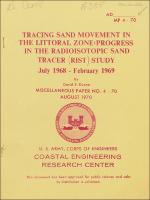Please use this identifier to cite or link to this item:
https://hdl.handle.net/11681/22196Full metadata record
| DC Field | Value | Language |
|---|---|---|
| dc.contributor.author | Duane, David B. | - |
| dc.date.accessioned | 2017-05-03T21:30:31Z | - |
| dc.date.available | 2017-05-03T21:30:31Z | - |
| dc.date.issued | 1970-08 | - |
| dc.identifier.uri | http://hdl.handle.net/11681/22196 | - |
| dc.description | Miscellaneous Paper | en_US |
| dc.description.abstract | Abstract: The Coastal Engineering Research Center, in cooperation with the Atomic Energy Commission, initiated a multiagency program to create a workable radioisotopic sand tracing (RIST) program. Tagging procedures, instrumentation, field surveys and data handling techniques were developed which permit collection and analysis of over 12,000 bits of information per hour over a survey track of approximately 18,000 feet. Data obtained can be considered as nearly synoptic observations of sediment transport in a single environmental zone or in adjacent beach, surf and offshore zones. Studies at Surf, California, indicate that sand labeled with the radioisotope of gold 198-199 provides much more data for analysis of sediment movement than does sand labeled with xenon-133. Surveys conducted confirm that, in response to any given set of wave conditions, a very different rate of sediment movement occurs in the zones between the high water line and -15 feet mean lower low water: Because of these differences, tracing surveys confined solely to the foreshore or offshore zone produce data only partially indicative of transport in the zone of immediate concern to coastal engineers. While an accurate determination of sediment drift volume remains illusive, qualitative data on sediment movement useful for engineering purposes can be obtained on a scale heretofore unattainable. | en_US |
| dc.language.iso | en_US | en_US |
| dc.publisher | Coastal Engineering Research Center (U.S.) | en_US |
| dc.publisher | Engineer Research and Development Center (U.S.) | en_US |
| dc.relation.ispartofseries | Miscellaneous Paper;no. 4-70 | - |
| dc.rights | Approved for public release; distribution is unlimited. | - |
| dc.source | This Digital Resource was created from scans of the Print Resource. | - |
| dc.subject | Coast changes--California--Santa Barbara Co. | en_US |
| dc.subject | Radioisotopes in geology | en_US |
| dc.subject | Sand--California--Santa Barbara Co. | en_US |
| dc.title | Tracing sand movement in the littoral zone: progress in the radioisotopic sand tracer (RIST) study, July 1968-February 1969 | en_US |
| dc.type | Report | - |
| Appears in Collections: | Miscellaneous Paper | |
Files in This Item:
| File | Description | Size | Format | |
|---|---|---|---|---|
| CERC Miscellaneous Paper No 4-70.pdf | 15.56 MB | Adobe PDF |  View/Open |